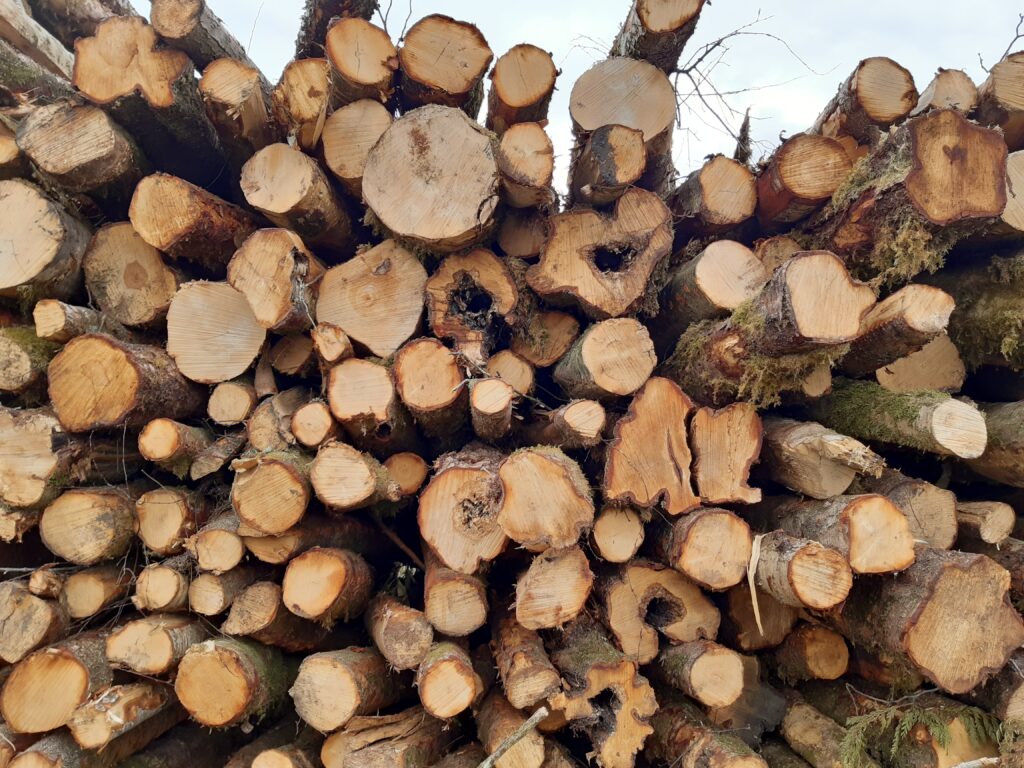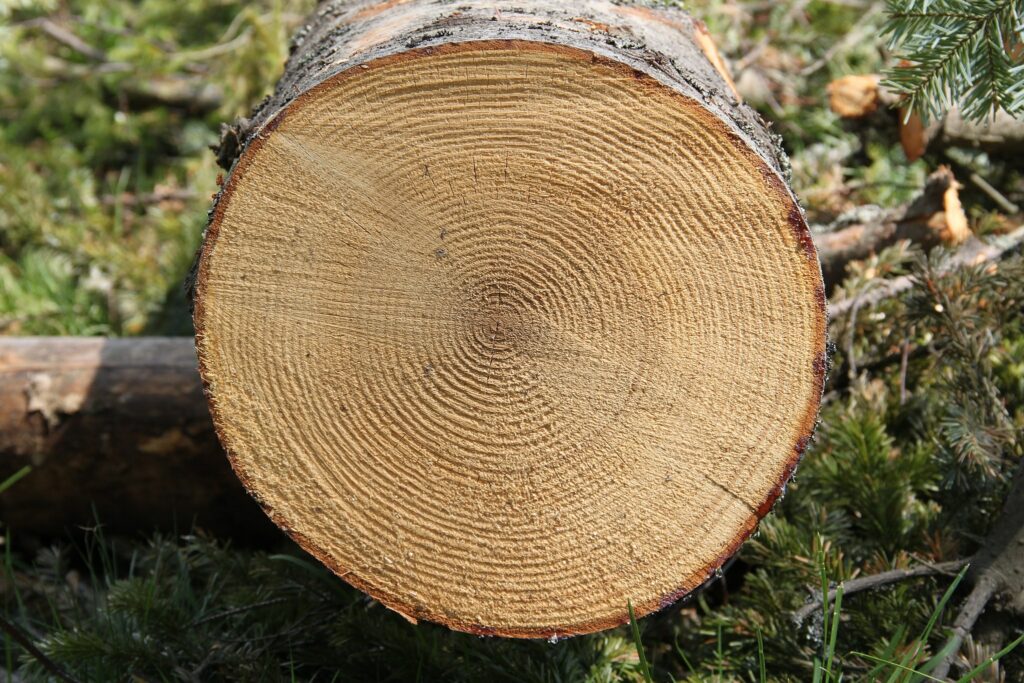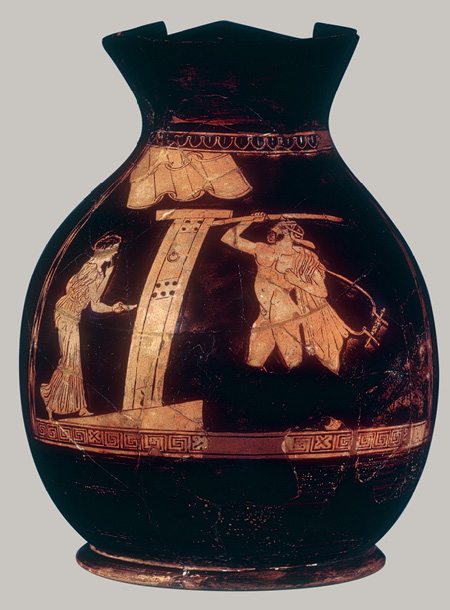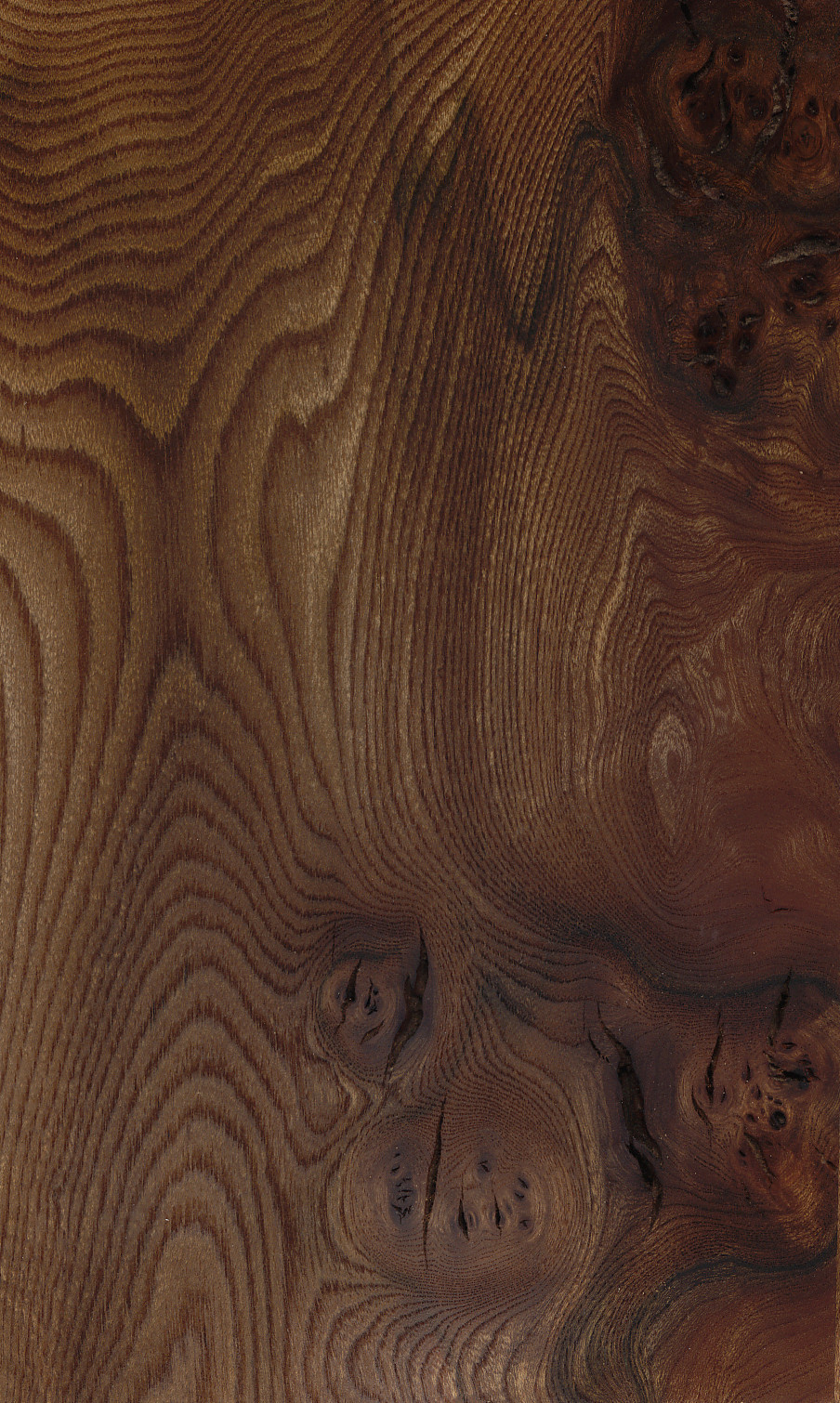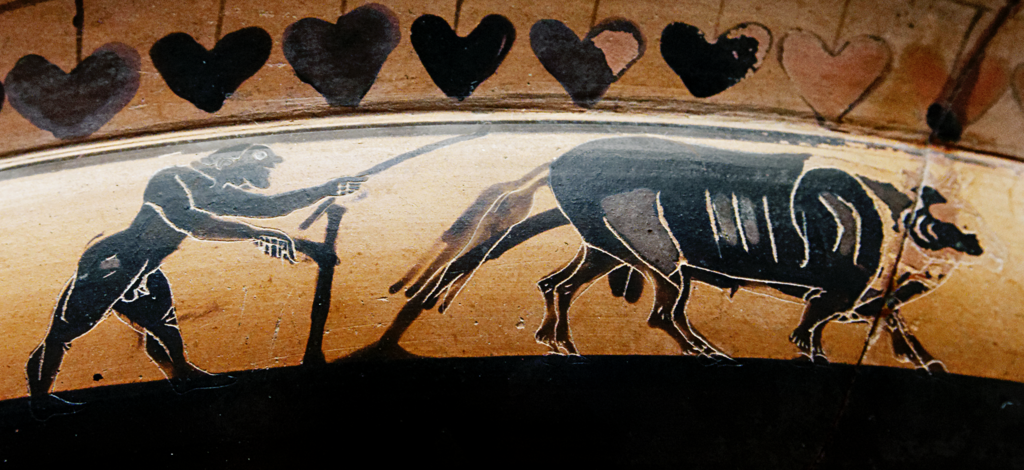“…we must endeavour to speak of timber [hulē], saying of what nature is that of each tree, what is the right season for cutting [temnein] it, which kinds are hard or easy to work, and anything else that belongs to such an enquiry.”
Theophrastus Enquiry into Plants 5.1.1, adapted from translation by Holt (p417)
Theophrastus, (c371–287 BCE) was a pupil of Plato and later a pupil and friend of Aristotle, and according to Holt (1906), “It may be surmised that it was from him that he first learnt the importance of that principle of classification which runs through all his extant works” (Introduction, xvii, xviii)
One major surviving work is Enquiry into Plants, in which according to Ierodiakonou (2020) “Theophrastus methodically laid out all the differences among plants, by distinguishing major categories and by drawing successive subdivisions within each of these categories; this involved the close study of the parts of plants, their morphology and reproduction, as well as relevant factors of habitat and cultivation.”
I was interested particularly in what trees were used for various purposes, and have made reference particularly to Enquiry into Plants Book 5 “Of the Timber of Various Trees and its Uses” for this post, along with some passages in other parts of the work, and a few comments from other classical sources.
In the previous post we saw Odysseus using various timbers to build his vessel, and Theophrastus also mentions different types of wood and explains how they were used:
“…the wood of the silver-fir [elatē] has many layers, like an onion: there is always another beneath that which is visible … Wherefore, when men are shaving this wood to make oars, they endeavour to take off the several coats one by one evenly: for, if they do this, they get a strong spar … The silver-fir [elatē] also gives timber of the greatest lengths and of the straightest growth; wherefore yard-arms and masts are made from it.”
Theophrastus Enquiry into Plants 5.1.7-8, adapted from translation by Holt (p423)Now silver-fir [elatē], fir [peukē] and Syrian cedar [kedros] are, generally speaking, useful for ship-building ; for triremes and long ships are made of silver-fir [elatinos], because of its lightness, and merchant ships of fir [peukinos], because it does not decay; while some make triremes of it also because they are ill provided with silver-fir [elatē]. The people of Syria and Phoenicia use Syrian cedar [kedros], since they cannot obtain much fir [peukē] either; while the people of Cyprus use Aleppo pine [pitus], since their island provides this and it seems to be superior to their fir [peukē]. Most parts are made of these woods; but the keel for a trireme is made of oak [druinos], that it may stand the hauling; and for merchantmen it is made of fir [peukinos]. However they put an oaken [druinos] keel under this when they are hauling, or for smaller vessels a keel of beech [oxuinos]; and the sheathing is made entirely of this wood.
… The cutwater, to which the sheathing is attached, and the catheads are made of manna-ash [melia] mulberry [sukaminos] and elm [ptelea]
5.7.1–3, adapted from translation by Holt (pp455–459)The beech [oxúē] … In mountain country it also grows white and has timber [xulon] which is useful for … shipbuilding; while the tree of the plains is black and useless or these purposes.”
3.10.1, adapted from translation by Holt (p223)
As well as ship-building, various types of wood are mentioned in connection with house-building. There are a couple of references to the roofs:
Of wild trees which are used for roof-timbers the wood of the silver-fir [elatinos] is the least compact, and among others that of the elder [aktinos], fig [sukinos], apple [mēlea] and bay [daphnē].
Theophrastus Enquiry into Plants 5.3.3, adapted from translation by Holt (p433–435)“As to the sweet chestnut [karua Euboikē], which grows tall and is used for roofing, it is said that when it is about to split, it makes a noise, so that men are forewarned: this occurred once at Antandros at the baths, and all those present rushed out. ”
5.6.1, adapted from translation by Holt (p453)
One might hope roof timbers would not split at all; perhaps the heat and steam from the baths caused the failure that Antandros experienced!
Theophrastus also mentions that elm has its use for constructing doors:
“The wood [xulon] is yellow [xanthos], strong, fibrous [euinos] and tough; for it is all heart. Men use it for expensive doors: it is easy to cut when it is green [khlōros], but difficult when it is dry [xeros].”
Theophrastus Enquiry into Plants 3.14.1, adapted from translation by Holt (p251)“The wood of the elm [ptelea] is the least likely to warp; wherefore they make the ‘hinges’ of doors out of elm wood [pteleïnos]; for, if these hold, the doors also keep in place”
5.3.5, adapted from translation by Holt (p435)
But Theophrastus reports that other types of wood were used for constructing houses (and other things!):
For house-building a … variety is used, silver-fir [elatē], fir [peukē] and prickly cedar [kedros]; also cypress [kuparittos], oak [drûs] and Phoenician cedar [arkeuthos]. In fact, to speak generally, any wood is here of service, unless it is altogether weak: for there are various purposes for which different woods are serviceable…. While other woods are serviceable for special articles belonging to various crafts, such as furniture, tools and the like, the wood of silver-fir [elatē] is of use for almost more purposes than any other wood ; for it is even used for painters’ tablets [pinax].
Theophrastus Enquiry into Plants 5.7.4, adapted from translation by Holt (p459)Oak [drûs] is used for house-building, for ship-building, and also for underground work; lime [philura] for the deck-planks [sanidōma] of long ships, for boxes, and for the manufacture of measures; its bark [phloios] is also useful for ropes and writing-cases [kistē], for these are sometimes made of it.
5.7.5-7, adapted from translation by Holt (p461)
Writing cases are mentioned again:
The kerasos (bird-cherry) … bark [phloios] in smoothness, colour and thickness is like that of the lime [philura]; wherefore men make their writing-cases [kistē] from it, as from the bark [phloios] of that tree.”
Theophrastus Enquiry into Plants 3.13.1, adapted from translation by Holt (p243)
As for tools and other household items, Theophrastus says:
Maple [sphendamnos] and zygia [=a type of maple] are used for making … the yokes of beasts of burden: …: kermes-oak [prînos] for the axles of wheelbarrows and the cross-bars of lyres and psalteries: beech [oxuē] for making waggons and cheap carts: elm [ptelea] for making doors and weasel-traps, and to some extent it is also used for waggon work; pēdos for waggon-axles and the stocks of ploughs: arbutus [andrachlē] is used for women for parts of the loom: Phoenician cedar [arkeuthos] for carpenters’ work and for work which is either to be exposed to the air or buried underground, because it does not decay. Similarly the sweet chestnut [karua Euboïkē] is used, and it is even less likely to decay if it is used for underground work. Box [puxos] is used for some purposes
Theophrastus Enquiry into Plants 5.7.6-7, adapted from translation by Holt (p461)
He mentions weasel traps here. For other hunting and fishing apparatus we can find further details about how they were made from other sources:
[11] Caltrops [= snares] are set for deer in the mountains, about meadows and streams and glades, in alleys and cultivated lands that they frequent. [12] The caltrops should be made of plaited yew [smîlax], stripped of the bark [= not periphloios], so as not to rot. They should have circular crowns, and the nails should be of iron and wood [xulinos] alternately, plaited into the rim … [13] …The noose itself and the cord must be strong; and the clog [xulon] attached must be of common oak [drûs] or evergreen oak [prînos], twenty-seven inches long, not stripped of the bark [periphloios], and three inches thick.
[14] To set the caltrops make a round hole in the ground … [15] Having done this lay the caltrop on the hole a little below the surface, and level, and put the noose of the cord round the top. Having laid the cord and the clog [xulon] in their places, lay spindle-wood [aktraktulis] twigs [dokis] on the top, not letting them stick out beyond the circle, and on these any light leaves [petalon] in season.
Xenophon On Hunting 9.11–15, adapted from translation by Marchant & Bowerstock
Polybius describes fishing for sword-fish at the Scyllaean rock, where using different types of wood for the harpoon has a practical advantage:
the man with the spear [doru] strikes it at close quarters, and then pulls the spear-shaft [doru] away leaving the harpoon in the fish’s body; for it is barbed and loosely fastened to the shaft [doru] on purpose, and has a long rope attached to it. They then slacken the rope for the wounded fish, until it is wearied out with its convulsive struggles and attempts to escape, and then they haul it on to land, or, if its size is not too great, into the boat. And if the spear-shaft [doru] falls into the sea it is not lost; for being made of two pieces, one oak [drûs] and the other pine [elatē], the oak [druinos] end as the heavier dips under water, the other end rises above it and is easily got hold of.
Polybius Histories 34.3 adapted from translation by Shuckburgh
Despite the references to ash-spears in Homer, I could not find anywhere that Theophrastus mentions that use for this type of wood, nor in general much about weapons, other than this:
Of the cornelian cherry (cornel) [kraneia]: “The wood of the ‘male’ tree has no heart, but is hard throughout, like horn in closeness and strength; whereas that of the ‘female’ tree has heart-wood [enteriōnē] and is softer and goes into holes; wherefore it is useless for javelins.”
Theophrastus Enquiry into Plants 3.12.1, adapted from translation by Holt (p235)
Presumably we should infer that the ‘male’ tree is good for making javelins or spears.

There are plenty of examples, as we have seen, related to farming, and there are also more general uses, including carpentry:
Hybrid arbutus [apharkē] is used for making stakes and for burning: holly [kēlastra] and Judas-tree [sēmuda] for walking-sticks: some also use bay [daphnē] for these; for of this they make light sticks and sticks for old men. Willow [itea] is used for shields, hampers, baskets and the like. We might in like manner add the several uses of the other woods. Distinction is also made between woods according as they are serviceable for one or other of the carpenter’s tools: thus hammers and gimlets are best made of wild olive [kotinos], but box [puxinos], elm [pteleïnos] and manna-ash [meleïnos] are also used, while large mallets are made of Aleppo pine [pituïnos].
Theophrastus Enquiry into Plants 5.7.7–8, adapted from translation by Holt (p463)
He elaborates:
The willow [itea]… grows by the water, and there are many kinds. … The black kind has boughs [rhabdos] which are fairer and more serviceable for basket-work, while those of the white are more brittle.
Theophrastus Enquiry into Plants 3.13.7, adapted from translation by Holt (p249)[Of the semyda:] “the bark [phloios] is variegated and the wood [xulon] light; it is only of use for making walking sticks and for no other purpose.
3.14.4, adapted from translation by Holt (p253)The filbert [karuon]… wood [xulon] is extremely tough, so that men make baskets even of the quite thin twigs [rhabdion], having stripped them of their bark, and of the stout ones when they have whittled them.
3.15.2, adapted from translation by Holt (p253–255)

We have seen wood used for constructing houses; there is evidence that it was also used for furniture-making:
The beech [oxuē] … has timber [xulon] which is useful for many purposes, for making carts, beds, chairs and tables…”
Theophrastus Enquiry into Plants 3.10.1-2, adapted from translation by Holt (p223)Manna-ash [melia] and beech [oxuē] have very moist wood, for of these they make elastic bedsteads.
5.6.3, adapted from translation by Holt (p455)Maple [sphendamnos] and zgygia [=a type of maple] are used for making beds … yew [mîlos] for the ornamental work attached to chests and footstools and the like
5.7.5-7, adapted from translation by Holt (p461)There is … another tree [dendron] [=Sissoo wood, footnote 6] which … has a sort of reddish variegation … and of it are made beds and couches and other things of superior quality.”
5.3, adapted from translation by Holt (p433)“Alder [klēthra]… has rough bark [phloios], which on the inner side [enteriōnē] is red [eruthros]: wherefore it is used for dyeing hides.”
3.14.3, adapted from translation by Holt (pp 251–253)
These details suggest that home furnishings could be made of wood chosen not only for durability or ease of working, but also for its rich color or decorative qualities, and similarly that hides were not always left in their natural state!
A previous post at Kosmos, “Gifts from the earth,” looked at mines and mining, and Theophrastus provides information about the wood involved in the various parts of the process:
The best charcoal [anthrax] is made from the closest wood, such as aria (holm-oak), oak [drûs], arbutus [komaros]; for these are the most solid, so that they last longest and are the strongest; wherefore these are used in silver-mines for the first smelting of the ore.
Theophrastus Enquiry into Plants 5.9.1, adapted from translation by Holt (p467)in iron-mines they use that which is made of sweet chestnut [karua] when the iron has been already smelted, and in silver-mines they use charcoal of pine-wood [pituïnos]: and these kinds are also used by the crafts. Smiths require charcoal of fir [peukinos] rather than of oak [druinos]: it is indeed not so strong, but it blows up better into a flame, as it is less apt to smoulder: and the flame from these woods [xulos] is fiercer.
5.9.2-4, adapted from translation by Holt (p469)
Whether for mining, heating, cooking, or burning anything, it was essential to be able to kindle a fire:
Fire-sticks [pureîon] are made from many kinds of wood, but best, according to Menestor, from ivy [kittós]: for that flares up most quickly and freely. They say also that a very good fire-stick is made of the wood which some call traveller’s joy [athragenē]; this is a tree [dendron] like the vine [ampelos] or the ‘wild vine [oinanthē],’ which, like these, climbs up trees [dendron]. The stationary piece should be made of one of these, the drill of bay [daphnē]; for the active and passive parts of the apparatus should not be of the same species, but different in their natural properties to start with, one being of active, the other of passive character. Nevertheless they are sometimes made of the same [wood], and some suppose that it makes no difference. They are made in fact of buckthorn [rhamnos], kermes-oak [prînos], lime [philura], and almost any wood except olive [elaa]; which seems surprising, as olive-wood [elaa] is rather hard and oily; however it is plainly its moisture which makes it less suitable for kindling. The wood of the buckthorn [rhamnos] is also good, and it makes a satisfactory stationary piece; for, besides being dry and free from sap it is necessary that this should also be of rather open texture, that the friction may be effectual; while the drill should be one which gets little worn by use. And that is why one made of bay [daphnē] is best; for, as it is not worn by use, it is effective through its biting quality.
Theophrastus Enquiry into Plants 5.9.6–7, adapted from translation by Holt (p473)
Apart from day-to-day living, wood had its place in decorative, ritual and sacred contexts:
Palm-wood [phoînix] is light, easily worked, and soft….Wherefore men now make their images [eidōlon] of palm-wood [phoînix] and have given up the wood of cork-oak [phellos].
Theophrastus Enquiry into Plants 5.3.6, adapted from translation by Holt (p437)Images [agalma] are carved from these woods, prickly cedar [kedros], cypress [kuparittos], nettle-tree [lōtos], box [puxos], and the small ones also from the roots [rhiza] of the olive [elaḯneos], which are unbreakable and of a more or less uniformly fleshy character.
5.3.7, adapted from translation by Holt (p439)
Pausanias, writing in the 2nd century CE, has a different list:
In days of old, men made wooden images [xoanon], so far as I have been able to discover, from the following trees: ebony [ebenos], cypress [kuparissos], cedar [kedros], oak [druinos], yew [mîlax], lotus [lōtos]. But the image [agalma] of Cyllenian Hermes is made of none of these, but of juniper wood [thuon]. Its height, I conjecture, is about eight feet.
Pausanias Description of Greece 8.17.2, adapted from translation by Jones
If you have come across other passages where different types of timber are mentioned, which trees are they from, and what are they used for? Do they agree with the usages reported by Theophrastus—or the other authors—in the passages in this post? Please share any examples in the Forum!
Selected vocabulary
Based on definitions in LSJ:
áktinos [ἄκτινος] adj. of elder-wood
aktraktulís [ἀτρακτυλίς or ἀτρακτυλλίς ἀτρακτυλίίδος, ἡ] spindle-thistle
ámpelos [ἄμπελος, ἀμπέλου, ἡ] grape-vine
andrákhlē [ἀνδράχλη, ἡ,] arbutus
ánthrax [ἄνθραξ, ἄνθρακος, ὁ] charcoal
aphárkē [ἀφάρκη, ἡ] hybrid arbutus
árkeuthos [ἄρκευθος, ἀρκεύθου, ἡ] juniper, Phoenician cedar
athragénē [ἀθραγένη, ἀθραγένης, ἡ] smoke-wood, traveller’s joy
dáphnē [δάφνη] laurel, bay
dokís [δοκίς , ίδος, ἡ,] plank
druínos [δρύινος] adj. oaken, of oak
drûs [δρῦς, δρυὸς, ἡ] tree, oak
elaía or eláa [ἐλαία, ἐλαίας/ἐλάα, ἐλάας ἡ,] olive-tree
elaḯneos [ἐλαΐνεος] adj. of olive-wood
elátē [ἐλάτη, ἐλάτης, ἡ] pine, fir; translated as silver-fir by Holt
elátinos [ἐλάτινος] adj. of fir or pine-wood
enteriṓnē [ἐντεριώνη , ἡ] inmost part, pith or heart-wood
eúinos [εὔινος, -ον] adj. with stout fibres
húlē [ὕλη] wood, forest; cut wood, firewood
itéa [ἰτέα, ἡ] willow
karúa [καρύα.] nut-bearing tree, esp. hazel, walnut; kárua Euboïkē sweet chestnut
káruon [κάρυον, τό] any kind of nut, filbert, walnut
kédros [κέδρος, κέδρου, ἡ] cedar-tree, cedar-wood
kēlástra [κηλάστρα, ἡ] holly
kerkís [κερκίς, κερκίδος, ἡ] aspen
klēthra [κλήθρα, or κλήθρρη, ἡ] alder
khlōrós [χλωρός, -ή, -όν] adj. green, greenish-yellow
kistē [κίστη, κίστης, ἡ] basket, hamper; writing-case, desk
kittós [κιττός, κιττοῦ, ὁ,] ivy
kómaros [κόμαρος, κομάρου, ἡ] strawberry-tree, arbutus
kótinos [κότινος, κοτίνου, ὁ (also ἡ] wild olive-tree
kráneia [κράνεια, κρανείας, ἡ] cornelian cherry, cornel, dog-wood
kupárittos [κυπάριττος, κυπαρίττου, ἡ,] cypress
lōtós [λωτός, λωτοῦ, ὁ] nettle-tree, lotus, clover
mēléa [μηλέα, μηλέας, ἡ] apple-tree
melía [μελία, μελίης, ἡ] ash
meléïnos [μελέϊνος, -η, -ον] adj. ashen
mîlos [μῖλος , ἡ,] yew
oinánthē [οἰνάνθη, οἰνάνθης, ἡ] vine
oxúa/oxúē [ὀξύα or ὀξύη] beech
oxúinos [ὀξύϊνος] adj. of beech-wood
pēdós [πηδός, ὁ,] type of tree
períphloios [περί-φλοιος, -ον] adj. with bark all round
pétalon [πέταλον, πετάλου, τό] leaf
peúkē [πεύκη, πεύκης, ἡ] pine, fir
peúkinos [πεύκινος] of, from, or made of pine or pine-wood
phellós [φελλός, φελλοῦ, ὁ] cork-tree, cork-oak
philúra [φιλύρα, φιλύρας, ἡ,] lime tree, linden
phloiós [φλοιός, φλοιοῦ, ὁ] bark
phoînix [φοῖνιξ] date-palm
pínax [πίναξ, πίνακος, ὁ,] board, plank; tablet
pitúïnos [πιτύϊνος, η, ον] made of pine
pítus [πίτυς, πίτυος, ἡ] pine
prînos [πρῖνος, πρίνου, ἡ, ὁ] holm-oak
pteléa [πτελέα, πτελέης, ἡ] elm
pteléïnos [πτελέϊνος] adj. of elm
pureîon [πυρεῖον, τό] firestick
puxínos [πύξινος, -η, ον] adj. made of boxwood
púxos [πύξος, ἡ] box-tree, box-wood
rhabdíon [ῥαβδίον, ῥαβδίου, τό] little rod or shoot
rhábdos [ῥάβδος, ῥάβδου, ἡ] rod, wand; young shoot of some trees
rhámnos [ῥάμνος, ῥάμνου, ἡ] prickly shrub, box-thorn, buckthorn
rhíza [ῥίζα, ῥίζης, ἡ:] a root
sanídōma [σανίδωμα, σανιδώματος, τό] planking, framework
sēmúda [σημύδα , ἡ] Judas-tree
smîlax [σμῖλαξ, σμίλακος, ἡ] yew; holm-oak; bindweed
sphéndamnos [σφένδαμνος, σφενδάμνου, ὁ or ἡ] Olympian maple
sukáminos [συκάμινος, συκαμίνου, ἡ] mulberry-tree
súkinos [σύκινος] adj. of the fig-tree
témnein [τέμνειν] to cut
xērós [ξηρός, -ή, -όν] adj. dry
xóanon [ξόανον, ξοάνου, τό,] image carved of wood
xulínos [ξυλινος, -η, -ον] adj. of wood, wooden
xúlon [ξύλον, ξύλου, τό] singular: piece of wood, log, beam, post; plural, wood cut and ready for use, firewood, timber
zúgia [ζυγία, ζυγίης, ἡ] maple
Related posts
Trees and Wood | Part 1: Homer and Hesiod
Bibliography
Hort, Sir Arthur. 1916. Theophrastus, Enquiry into Plants. London, New York
English translation via archive.org
Greek online at Scaife:
urn:cts:greekLit:tlg0093.tlg001.1st1K-grc1:1.1.1-1.1.5
Jones, W.H.S. Pausanias Description of Greece with an English Translation by W.H.S. Jones, Litt.D., and H.A. Ormerod, M.A., in 4 Volumes. Cambridge, MA, Harvard University Press; London, William Heinemann Ltd. 1918.
Online at Perseus
Greek text: Pausanias. Pausaniae Graeciae Descriptio, 3 vols. Leipzig, Teubner. 1903.
Online at Perseus
Ierodiakonou, Katerina, “Theophrastus”, The Stanford Encyclopedia of Philosophy (Winter 2020 Edition), Edward N. Zalta (ed.),
https://plato.stanford.edu/archives/win2020/entries/theophrastus/
LSJ: Liddell, Henry George, and Scott, Robert. A Greek-English Lexicon, revised and augmented throughout by Sir Henry Stuart Jones, with the assistance of Roderick McKenzie. 1940. Oxford. Clarendon Press.
Online at Perseus
Marchant, E.C. and Bowersock, G.W. 1925. Xenophon. Xenophon in Seven Volumes, 7. E. C. Marchant, G. W. Bowersock, tr. 1925. Constitution of the Athenians. Harvard University Press, Cambridge, MA; William Heinemann, Ltd., London.
Online at Perseus
Greek text: Xenophon. Xenophontis opera omnia, vol. 5. 1920 (repr.1969). Oxford, Clarendon Press.
Online at Perseus
Shuckburgh, Evelyn S. 1889. Histories. Polybius. Evelyn S. Shuckburgh. translator. London, New York. Macmillan. 1889. Reprint Bloomington 1962.
Online at Perseus
Greek text: Historiae. Polybius. Theodorus Büttner-Wobst after L. Dindorf. 1893-. Leipzig. Teubner.
Online at Perseus
Texts accessed July 2022
Image credits
Stack of felled trees.
Photo: Kosmos Society
Abies alba [silver fir] cross section
Photo: Crusier Creative Commons Attribution-Share Alike 3.0 Unported license via Wikimedia Commons
Terracotta oinochoe, chous, jug c 430–420 BCE, showing roof and door of a house, and a man with a stick
Public domain, via Metropolitan Museum of Art
Elm wood
Photo: Tom elm Creative Commons Attribution-Share Alike 4.0 International license, via Wikimedia Commons
Painter of the Burgon Sianas Ploughman. Attic Black-Figure Band Cup, c 560–550 BCE.
Photo: Marie-Lan Nguyen 2011, Creative Commons Attribution-Share Alike 2.5 Generic license, via Wikimedia Commons
Carpenter at work. Red-figured kylix, 510–500 BCE. British Museum 1836,0224.231
Creative Commons Attribution-NonCommercial-ShareAlike 4.0 International (CC BY-NC-SA 4.0) license.
© The Trustees of the British Museum
Hand drill: ancient fire making methods, illustration from Popular Science Monthly Volume 10, 1876
Public domain, via Wikimedia Commons
Note: Images have been selected from pictures that are freely available with open source or Creative Commons licenses or from photographs sent in by community members for the purpose. The images in this post are intended to suggest the subject, rather than illustrate exactly—as such, they may be from other periods, subjects, or cultures. Attributions are based where possible by those shown by museums, or on Wikimedia Commons, at the time of publication on this website.
Images accessed July 2022.
__
Sarah Scott has a degree in Language from the University of York, and has worked as an editor, technical author, and documentation manager. She is the Executive Producer for the HeroesX project, and one of the Executive Editors of the HeroesX Sourcebook. She is an active participant and member of the editorial team in Kosmos Society, with a particular interest in content development, document management, word studies, language learning, comparative linguistics, and digital humanities.
